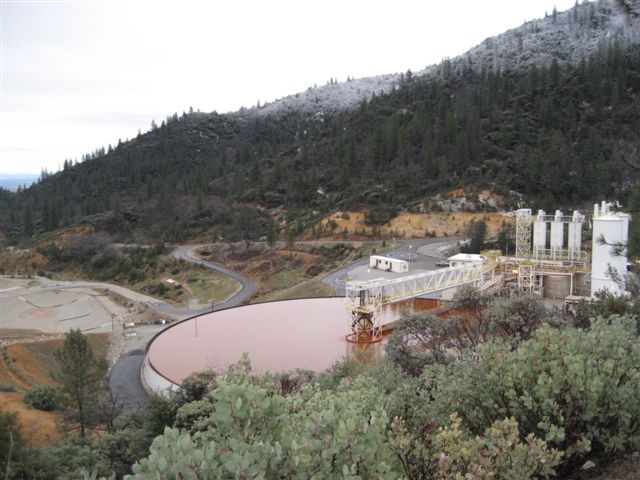

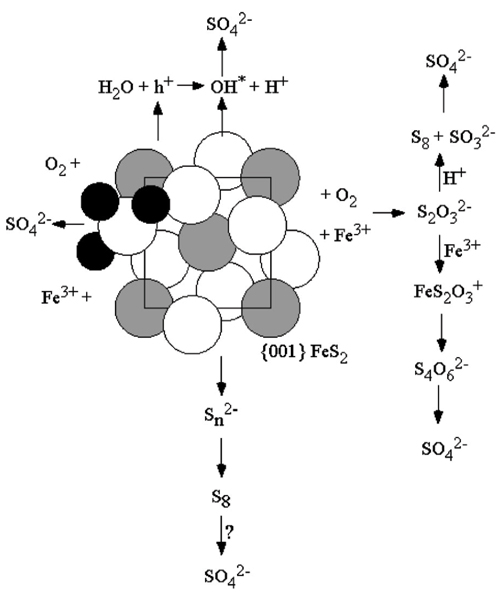
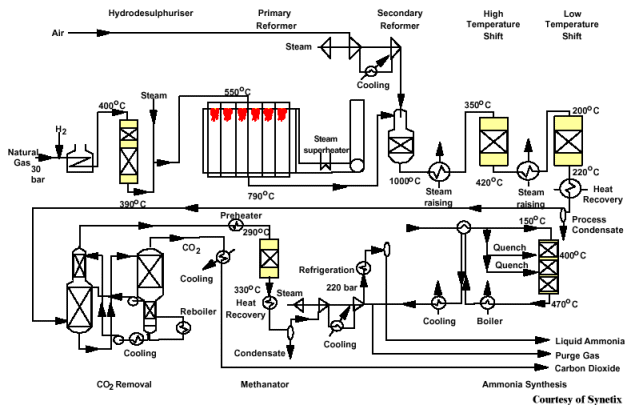
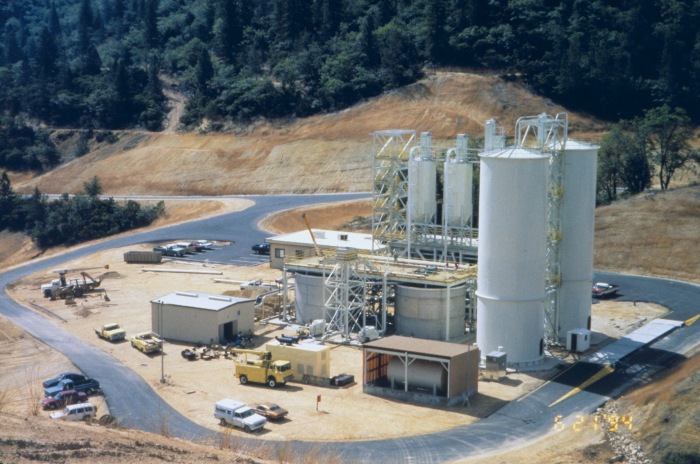
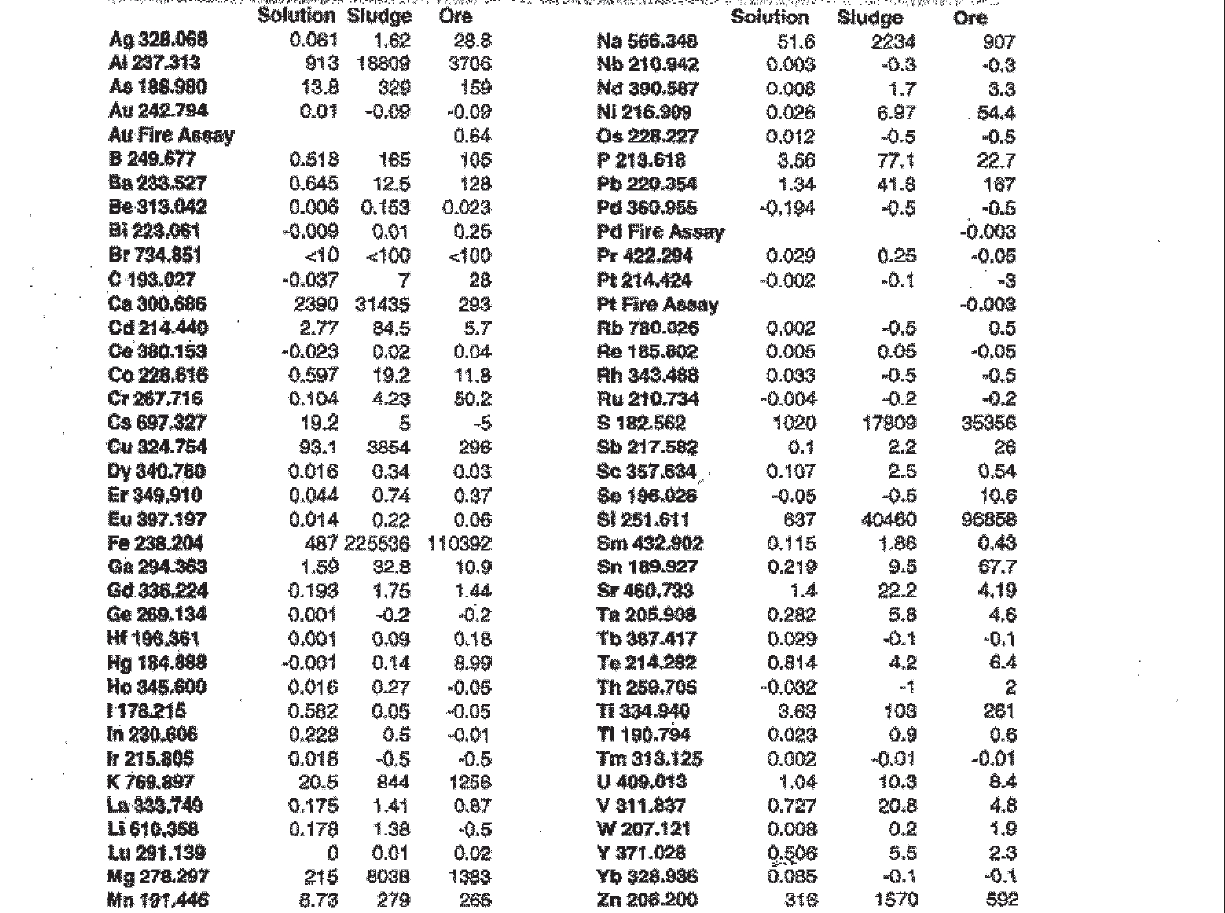
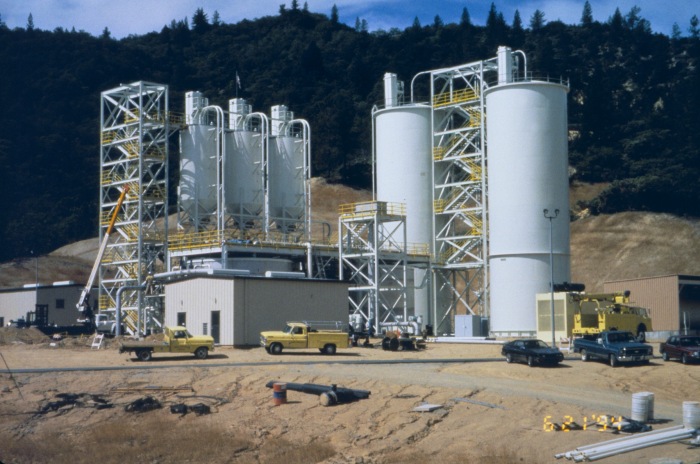


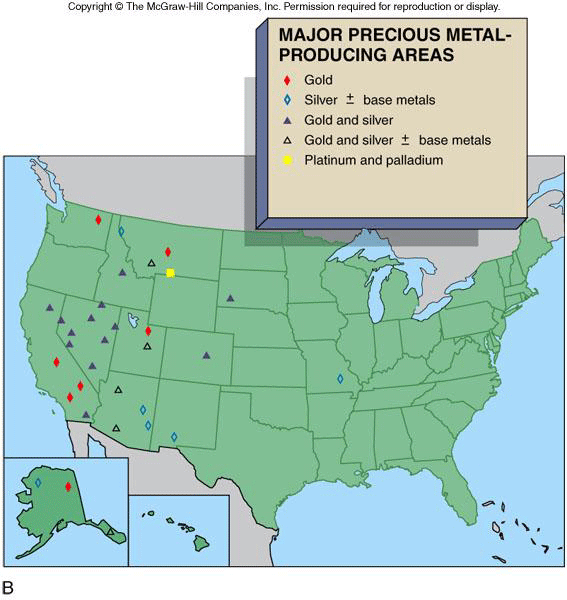

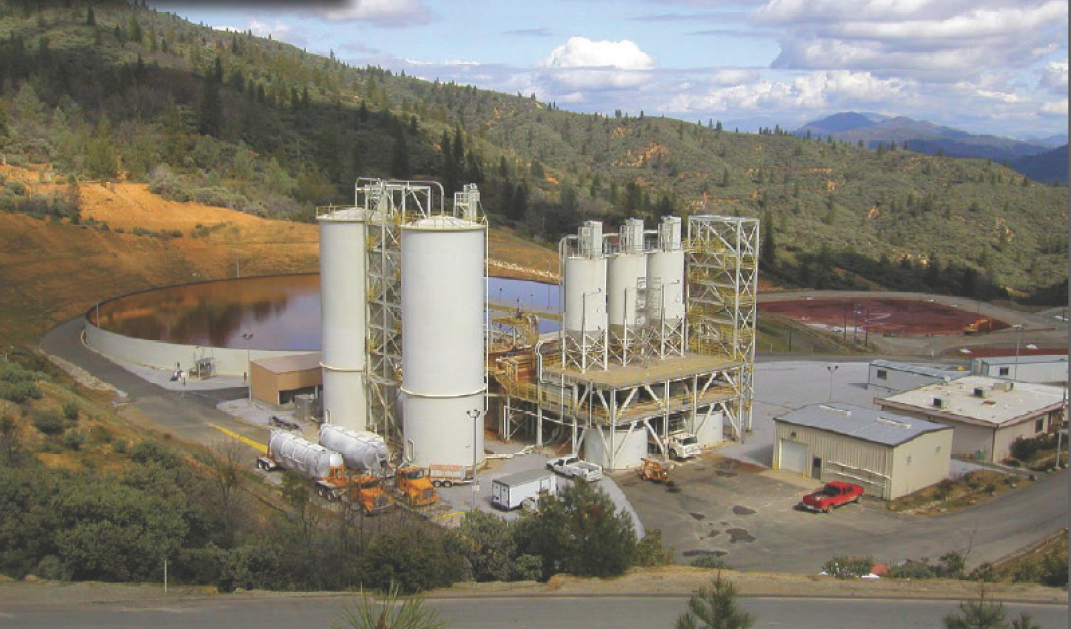
University of California Davis Professor Ting Guo discovers Iron nano-catalysts (Fe-Al-Ni) catalyst for Fischer-Tropsch reaction and converts carbon dioxide from air to carbon nano-tubes.
"One thing Fe is relatively good at is catalyzing Fischer-Tropsch synthesis of liquid fuels from syngas (CO + H2), which happens at 300 C or so. It is possible that we can convert your iron into materials good for catalyzing FTS, which can be used after methane and CO2 are converted to syngas using Ni catalysts at 900 C. We need to test to see if the iron catalysts from your waste is good for this purpose. Mixing them with carbon paste is an option. Because the reaction temperature is relatively low, we may not need to use nanotubes to anchor the catalysts. " Ting Guo, November 21, 2008
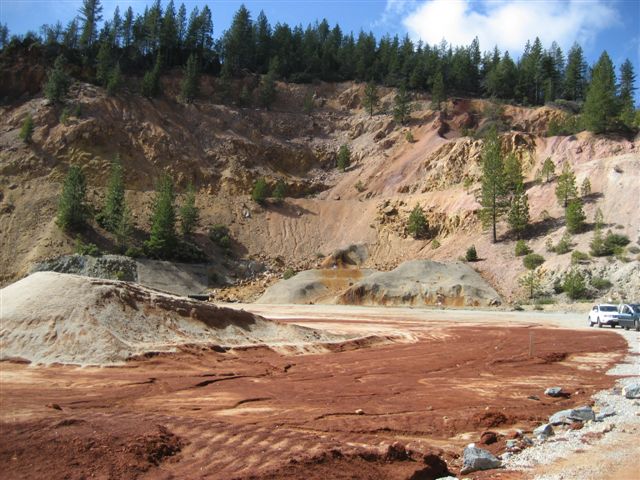
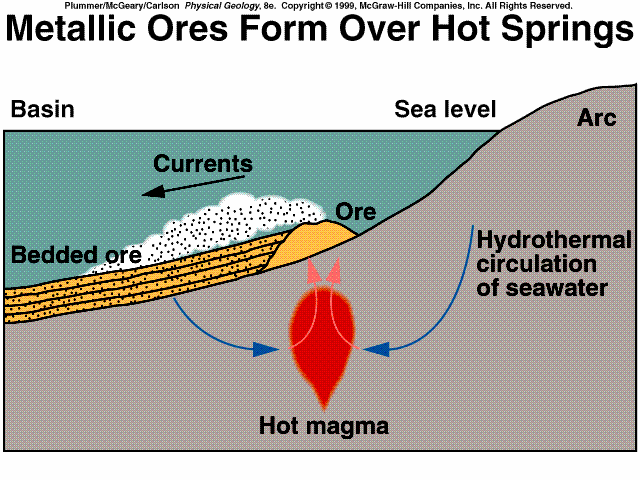
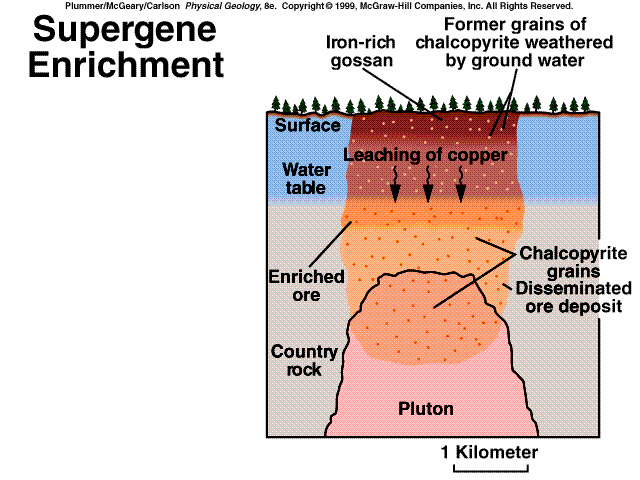
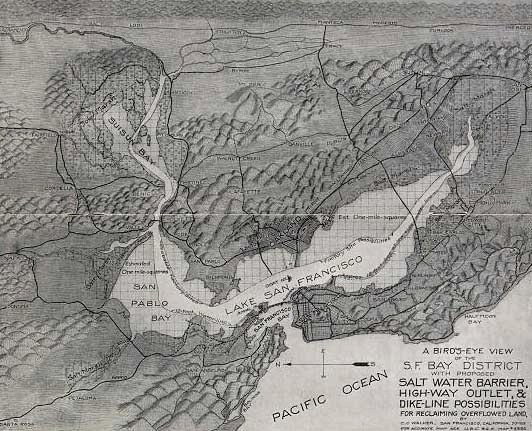


IRON MOUNTAIN MINE, TOWNSHIP OF MINNESOTA, SUGARLOAF WATER DISTRICT
FERC EXEMPTION ID #F 1967-34 WATER RECLAMATION PLAN
Purpose.
The State policies described in Water Code Sections 461 and 13510 are in the best interest of Iron Mountain Mine and the Township of Minnesota . The majority of jurisdictions in Shasta County have adopted measures to promote water reclamation. This chapter is necessary to protect the common water supply of the region which is vital to public health and safety, and to prevent endangerment of public and private property. Shasta County is highly dependent on limited domestic water for domestic, agricultural and industrial uses. The reliability of the supply of domestic water is uncertain. By developing and utilizing reclaimed water, the need for exportable water can be eliminated. In light of these circumstances, certain uses of potable water may be considered unreasonable or to constitute a nuisance where reclaimed water is available or production of reclaimed water is unduly impaired. Reclaimed water would be more readily available in seasons of drought when the supply of potable water for nonessential uses may be uncertain.
It is the policy of the Iron Mountain Mine and the Township of Minnesota that reclaimed water shall be used within the jurisdiction wherever its use is economically justified, financially and technically feasible, and consistent with legal requirements, preservation of public health, safety and welfare, and the environment.
The following terms are defined for purposes of this chapter:
A. “Agricultural purposes” include the growing of field and nursery crops, raw crops, trees, and vines and the feeding of fowl and livestock.
B. “Artificial lake” means a human-made lake, pond, lagoon, or other body of water that is used wholly or partly for landscape, scenic or non-contact recreational purposes.
C. “Commercial office building” means any building for office or commercial uses with water requirements which include, but are not limited to, landscape irrigation, toilets, urinals, and decorative fountains.
D. “Reclaimed water distribution system” means a piping system intended for the delivery of reclaimed water separate from and in addition to, the potable water distribution system.
E. A “greenbelt area” includes, but is not limited to, golf courses , cemeteries, parks and landscaping.
F. “Industrial process water” means water used by any industrial facility with process water requirements which include, but are not limited to, rinsing, washing, cooling and circulation, or construction.
G. “Off-site facilities” means water facilities from the source of supply to the point of connection with the on-site facilities, normally up to and including the water meter.
H. “On-site facilities” means water facilities under the control of the owner, normally downstream from the water meter.
I. “Potable water” means water which conforms to the Federal, State and local standards for human consumption.
J. “Reclaimed water” means water which, as a result of treatment of wastewater, is suitable for a direct beneficial use or controlled use that would not otherwise occur (see Water Code Section 13050(n)).
K. “Water discharge” means water deposited, released, or discharged into a sewer system from any commercial, industrial, or residential source which contains levels of any substance or substance which may cause substantial harm to any water treatment or reclamation facility or which may prevent use of reclaimed water authorized by law.
A. General. Upon adoption of this chapter, the Township shall prepare and adopt by resolution, a water reclamation master plan to define, encourage, and develop the use of reclaimed water within its boundaries. The master plan shall be updated not less often than every five years.
B. Contents of the Reclamation Master Plan. The master plan shall include, but not be limited to, the following:
1. Plants and Facilities. Evaluation of the location and size of present and future reclamation treatment plants, distribution pipelines, pump stations, reservoirs, and other related facilities, including cost estimates and potential financing methods;
2. Reclaimed Water Service Areas. A designation, based on the criteria set forth in this chapter, of the areas within the Township that can or may in the future use reclaimed water in lieu of potable water. Reclaimed water uses may include, but are not limited to, the irrigation of greenbelt and agricultural areas, filling of artificial lakes, and appropriate industrial and commercial uses;
3. Designate Tributary Areas. For each water reclamation facility identified in the master plan, designate proposed tributary areas. Within such areas, discharges to the sewage system shall be subject to permitting, monitoring and control measures to protect public health, safety and public and private property;
4. Quality of Water to be Reclaimed. For each water reclamation treatment facility, evaluate water quality with respect to the effect on anticipated uses of reclaimed water to be served by each treatment facility. Evaluate sources of waste discharge and sewer inflow that may, directly or cumulatively, substantially contribute to adverse water quality conditions (including but not limited to total dissolved solids , sodium, chloride and boron) in reclaimed water;
5. Tributary Protection Measures. Develop recommended control measures and management practices for each designated tributary area to maintain or improve the quality of reclaimed water. Such control measures may include capital improvements to the sewer collection system and waste discharge restrictions for industrial, commercial and residential discharges;
6. Mandatory Reclaimed Water Use. For each reclaimed water service area, evaluate whether greenbelt irrigation, agricultural irrigation, commercial office buildings, filling of artificial lakes, or industrial processes shall be limited to the use of reclaimed water. As appropriate, mandate construction of reclaimed water distribution systems or other facilities in new and existing developments for current or future reclaimed water use as a condition of any development approval or continued water service, if future reclamation facilities are proposed in the master plan that could adequately serve the development. Identify resources and adopt measures to assist water users in the financing of necessary conversions;
7. Rules and Regulations. Establish by resolution, general rules and regulations governing the use and distribution of reclaimed water;
8. Public Awareness Program. Establish a comprehensive water reclamation public awareness program;
9. Coordination Among Agencies. An examination of the potential for initiating a coordinated effort between the Township and other regional agencies to share in the production and utilization of reclaimed water.
A. Existing Potable Water Service.
1. Preliminary Determination. Based upon the master plan, upon the designation of each reclaimed water service area or the commencement of the design of new reclaimed water facilities, the Township shall make preliminary determinations as to which existing potable water customers shall be converted to the use of reclaimed water. Each water customer shall be notified of the basis for a determination that conversion to reclaimed water service will be required, as well as the proposed conditions and schedule for conversion.
2. Notice. The notice of the preliminary determination, including the proposed conditions and time schedule for compliance, and a reclaimed water permit application shall be sent to the water customer by certified mail.
3. Objections – Appeals. The water customer may file a notice of objection with the Township within 30 days after of any notice of determination to comply is delivered or mailed to the customer, and may request reconsideration of the determination or modification of the proposed conditions or schedule for conversion. The objection must be in writing and specify the reason for the objection. The preliminary determination shall be final if the customer does not file a timely objection. The Township Manager or his designee, shall review the objection with the objector, and shall confirm, modify or abandon the preliminary determination.
B. Development and Water Service Approvals.
1. Conditions. Upon application by a developer, owner or water customer (herein referred to as “applicant”) for a tentative map, subdivision map, land use permit, or other development project as defined by Government Code Section 65928 the Township staff shall review the master plan and make a preliminary determination whether the current or proposed use of the subject property is required to be served with reclaimed water or to include facilities designed to accommodate the use of reclaimed water in the future. Based upon such determination, use of reclaimed water and provision of reclaimed water distribution systems or other facilities for the use of reclaimed water, and application for a permit for such use may be required as a condition of approval of any such application, in addition to any other conditions of approval.
2. Alterations and Remodeling. On a case-by-case basis, upon application for a permit for the alteration or remodeling of multifamily, commercial or industrial structures (including, for example, hotels), the Township staff shall review the master plan and make a preliminary determination whether the subject property shall be required to be served with reclaimed water or to include facilities designed to accommodate the use of reclaimed water in the future. Based upon such determination, use of reclaimed water and provision of reclaimed water distribution systems or other facilities for the use of reclaimed water, and application for a permit for such use, may be required as a condition of approval of the application.
3. Notice of Determination. A notice of the basis for the preliminary determination, proposed conditions of approval and schedule for compliance shall be provided to the applicant prior to approval of the development application.
C. Reclaimed Water Permit Process. Upon a final determination by the Township Manager that a property shall be served with reclaimed water, or adoption of a condition of development approval requiring use or accommodation of the use of reclaimed water, the water customer, owner or applicant shall obtain a reclaimed water permit.
1. Permit Conditions. The permit shall specify the design and operational requirements for the applicant's water distribution facilities and schedule for compliance and shall require compliance with both the California Department of Health Services Wastewater Reclamation Criteria (see California Code of Administrative Regulations, Title 22), and requirements of the Regional Water Quality Control Board.
2. Plan Approval. Plans for the reclaimed and potable water distribution systems for the parcel shall be reviewed by the Township Manager or his designee and a field inspection conducted before the permit is granted.
3. Iron Mountain mine joint venturers to develop soil remineralization franchise.
4 Iron Mountain mine joint venturers to construct superconducting supergrid.
5.Iron Mountain mine joint venturers to precast seismically engineered containment structures, schools, hospitals, and housing.
6. Permit Issuance. Upon approval of plans, the permit shall be issued. Reclaimed water shall not be supplied to a property until inspection by the Township Manager or his designee determines that the applicant is in compliance with the permit conditions.
D. Temporary Use of Potable Water. Upon the approval of the Township Manager or his designee, potable water may be made available temporarily. Before the applicant receives temporary potable water, a water reclamation permit must be obtained for new on-site distribution facilities. Prior to commencement of reclaimed water service, an inspection of the on-site facilities will be conducted to verify that the facilities have been maintained and are in compliance with the reclaimed water permit and current requirements for service. Upon verification of compliance, reclaimed water shall be served to the parcel for the intended use. If the facilities are not in compliance, the applicant shall be notified of the corrective actions necessary and shall have at least 30 days to take such actions.
E. Reclaimed Water Rate. The rate charged for reclaimed water shall be established by resolution of the Township.
Rancho Buena Ventura (also called "San Buena Ventura") was a 26,632-acre (107.78 km 2 ) Mexican land grant in present day Shasta County, California , given in 1844 by Governor Manuel Micheltorena to Major Pierson B. Reading (1816–1868). [ 1 ] The land grant is named for the former name of the adjacent Sacramento River , Buena Ventura, which meant good fortune in Spanish. The grant extended some nineteen miles on the west side of the Sacramento River, from Cottonwood Creek on the south to Salt Creek on the north, and extended approximately three miles west of the Sacramento River the length of the grant. [ 2 ] The grant encompassed present day towns of Anderson , Cottonwood and Redding . [ 3 ] This was the northernmost land grant in California. [ 2 ] Redding, however, was not named for Major Reading; it was named for B. B. Redding, a land agent for the Central Pacific Railroad . [ 2 ]
Governor Micheltorena and John Sutter , his alcalde granted Rancho Buena Ventura to Pierson B. Reading (listed as Pearson B. Reading in the land case documents) in 1844. Reading, who was at that time working for John Sutter at Sutter's Fort in Sacramento as a clerk and trapper, visited the land grant but did not move onto it. He stocked the land with cattle and built a house for his overseer but it was burned down by natives in 1846. [ 2 ] Reading was active in promoting the Bear Flag Revolt of 1846. After serving as an artillery lieutenant then as paymaster at the rank of major in a battalion led by John C. Frémont , he built a permanent adobe dwelling and settled on his grant in 1847. [ 2 ] He became the second (after Lansford Hastings ) permanent settler of what was to become Shasta County. [ 2 ]
With the cession of California to the United States following the Mexican-American War , the 1848 Treaty of Guadalupe Hidalgo provided that the land grants would be honored. As required by the Land Act of 1851, a claim for Rancho Buena Ventura was filed with the Public Land Commission in 1852. [ 4 ] The US appealed the claim on the grounds that Reading was not a Mexican citizen. [ 5 ] In 1854 Reading went to Washington, D.C. for the hearing before the US Supreme Court on his land grant claims. There he met and married Fanny Wallace Washington. The claim was upheld by the Supreme Court [ 5 ] and the grant was patented to Pearson B. Reading in 1857. [ 6 ]
The first land sale was made in 1853. By 1866, over 5,000 acres (20.2 km 2 ) of the land grant was sold. In 1866, Reading borrowed from the estate of his longtime friend Samuel J. Hensley, using the remaining rancho lands as collateral. After Reading's unexpected death in 1868, the remaining rancho lands were sold to James Ben Ali Haggin at public auction in 1871 to satisfy the unpaid debt. [ 7 ] After the auction, the only remaining land from the original land grant was the one square mile (640 acres (2.6 km 2 )) Washington section purchased by Fanny Washington's mother.
William Magee was the U.S. deputy surveyor for Shasta County . Charles Camden was the most successful miner in Shasta County, he bought and sold much of the land at the Rancho, 800 acres for Military Scrip Warrants ( U.S. Patent Title), They were partners. Under their rights of Pre-emption The U.S. Land Office at Marysville granted 360 acres of land on Iron Mountain in lieu of land in the Rancho Buena Ventura. Mining was insignificant until James Sallee discovered a seam of sliver in the ore and the Lost Confidence Mine was recorded April 8, 1880.
PUBLIC RESOURCES CODE
SECTION 1-18
1. This act shall be known as the Public Resources Code.
4. No action or proceeding commenced before this code takes effect, and no right accrued, is affected by the provisions of this code, but all procedure thereafter taken therein shall conform to the provisions of this code so far as possible.
8. Writing includes any form of recorded message capable of comprehension by ordinary visual means. Whenever any notice, report, statement or record is required by this code, it shall be made in writing in the English language.
14. "County" includes "city and county."
PUBLIC RESOURCES CODE
SECTION 2755-2764
2755. The board shall adopt regulations that establish state policy for the reclamation of mined lands...(d) The procedure provided for in this section shall not be undertaken in any area that has been designated pursuant to Article 6 (commencing with Section 2790) if mineral resource management policies have been established and incorporated in the lead agency's general plan in conformance with Article 4 (commencing with Section 2755).
PUBLIC RESOURCES CODE
SECTION 2770-2779
2770. (a) Except as provided in this section, no person shall conduct surface mining operations.
There is no license from the United States or the state of California to miners to enter upon private lands of individuals for the purpose or extracting the minerals in the soil. (Biddle Boggs v Merced Min. Co.) 14 Cal. 279.)
ADOPTED REGULATION TEXT
Article 15. Vested Rights Determination
Section 3950. Purpose of Regulations.
No person who has obtained a vested right to conduct surface mining operations prior to January 1, 1976 shall be required to secure a permit pursuant to Section 2770 of the Public Resources Code. Any person claiming a vested right to conduct surface mining operations in a jurisdiction where the State Mining and Geology Board (the Board) is lead agency pursuant to section 2774.4 of the Public Resources Code must establish such claim in a public proceeding under this article. In such a proceeding the Claimant shall assume the burden of proof.
NOTE
Authority: Sections 2755 and 2775, Public Resources Code. Reference: Calvert v. County of Yuba, (2007) 145 Cal. App. 4th 613.
Section 3951 Vested Right(s) - Definition.
A “vested right” is the right to conduct a legal nonconforming use of real property if that right existed lawfully before a zoning or other land use restriction became effective and the use is not in conformity with that restriction when it continues thereafter. A vested mining right, in the surface mining context, may include but shall not be limited to: the area of mine operations, the depth of mine operations, the nature of mining activity, the nature of material extracted, and the quantity of material available for extraction.
A person shall be deemed to have a vested right or rights to conduct surface mining operations if, prior to January 1, 1976, the person has, in good faith and in reliance upon a permit or other authorization, if the permit or other authorization was required, diligently commenced
surface mining operations and incurred substantial liabilities for work and materials necessary for the surface mining operations. Expenses incurred in obtaining the enactment of an ordinance in relation to a particular operation or the issuance of a permit shall not be deemed liabilities for work or materials. Expansion of surface mining operations after January 1, 1976 may be recognized as a vested nonconforming use under the doctrine of Adiminishing assets” as set forth in Hansen Brothers Enterprises, Inc. v. Board of Supervisors (1996) 12 Cal.4th 533.
NOTE
Authority: Sections 2755, 2776 and 2775, Public Resources Code; Hansen Brothers Enterprises, Inc. v. Board of Supervisors (1996) 12 Cal.4th 533.) Reference: Calvert v. County of Yuba, (2007) 145 Cal. App. 4th 613.
TITLE 33 > CHAPTER 26 > SUBCHAPTER V > § 1371. Authority under other laws and regulations
"The rights of users of property as those rights existed at the time of the adoption of a zoning ordinance are well recognized and have always been protected." (Edmonds v. County of Los Angeles (1953) 40 Cal.2d 642 , 651 [255 P.2d 772].)
A " 'mine' " is defined as "all mineral bearing properties of whatever kind or character, whether underground, or in a quarry or pit, or any other source from which any mineral substance is or may be obtained." (§ 2200.) " 'Minerals' means any naturally occurring chemical element or compound, or groups of elements and compounds, formed from inorganic processes and organic substances, including, but not limited to, coal, peat, and bituminous rock, but excluding geothermal resources, natural gas, and petroleum." (§ 2005.)
The United States , like any other PRIVATE PROPRIETOR, with the exception of exemption from state taxation, having no municipal sovereignty or right of eminent domain within the limits of the state-cannot, in derogation of the rights of the local sovereign to govern the relations of the citizens of the state, and to prescribe the rules of property, and its mode of disposition, and its tenure, enter upon, or authorize an entry upon, private property, for the purpose of extracting minerals. The United States , like any other proprietor, can only exercise their rights to the mineral in private property, in subordination to such rules and regulations as the local sovereign may prescribe. Until such rules and regulations are established, the landed proprietor may successfully resist, in the courts of the state, all attempts at invasion of his property, whether by the direct action of the United States or by virtue of any pretended license under their authority. (Biddle Boggs v Merced Min. Co,,) 14 Cal. 279.)
“A valid and subsisting location of mineral lands, made and kept in accordance with the provisions of the statutes of the United States , has the effect of a grant by the United States of the right of present and exclusive possession of the lands located.”
U.S. Supreme Court, 1884
With the title passes away all authority or control of the executive department over the land and over the title which it has conveyed. It would be as reasonable to hold that any private owner who has conveyed it to another can, of his own volition, recall, cancel or annul the instrument which he has made and delivered. If fraud, mistake, error, or wrong has been done, the courts of justice present the only remedy. These courts are as open to the United States to sue for the cancellation of the deed or reconveyance of the land as to individuals, and if the government is the party injured this is the proper course”.
Moore v. Robbins, 96 U.S. 530, 533, 24 L. Ed. 848.
That whenever the question in any court, state or federal, is whether a title to land which has once been the property of the United States has passed, that question must be resolved by the laws of the United States; but that whenever, according to those laws, the title shall have passed, then that property, like all other property in the state, is subject to state legislation, so far as that legislation is consistent with the admission that the title passed and vested according to the laws of the United States”.
Wilcox v. McConnell, 13 Pet. ( U.S. ) 498, 517, 10 L. Ed. 264.
“Title by patent from the United States to a tract of ground, theretofore public, prima facie carries ownership of all beneath the surface, and possession under such patent of the surface is presumptively possession of all beneath the surface.
Lawson v. United States Min. Co. 207 U.S. 1, 8, 28 Sup. Ct. 15, 17, 52, L. Ed. 65.
Grub-stake contracts will be enforced by the courts, but only as other contracts; that is to say, it is not enough for parties to assert that they have rights, in order to secure legal protection, but they must be able to prove in each case a clear and definite contract, and that by the terms and conditions of such contract, and compliance therewith on their part, rights have become vested.
Cisna v. Mallory (C.C.) 84 Fed. 851, 854.
The common-law rule is that the lessee of real property may work already opened mines, but cannot open new ones. But the lease may expressly, or by implication from express powers, give the right to take the minerals, the instrument is a genuine lease.
"No Bill of Attainder or ex post facto Law shall be passed." - Article 1, Section 9, United States Constitution
No legislature, State or Federal, may pass a Bill of Attainder. See U.S. Const. Art. I, §§ 9-10. F.O.P. Lodge No. 121 v. City of Hobart , 864 F.2d 551, 556 (7th Cir., 1988)
A bill of attainder may affect the life of an individual, or may confiscate his property, or may do both.
In this form the power of the legislature over the lives and fortunes of individuals is expressly restrained...
Fletcher v. Peck , 10 U.S. (6 Cranch) 87, 138, 3 L.Ed. 162,178 (1810
...In 1810 , Chief Justice Marshall, speaking for the Court in Fletcher v. Peck , 6 Cranch 87, 138, stated that "[a] bill of attainder may affect the life of an individual, or may confiscate his property, or may do both." This means, of course, that what were known at common law as bills of pains and penalties are outlawed by the Bill of Attainder Clause. The Court's pronouncement therefore served notice that the Bill of Attainder Clause was not to be given a narrow historical reading (which would exclude bills of pains and penalties), but was instead to be read in light of the evil the Framers had sought to bar: Legislative punishment, of any form or severity, of specifically designated persons or groups. See also Ogden v. Sauders , 12 Wheat. 213, 286. United States v. Brown , 381 U.S. 437, 447 (1964
A bill of attainder is a legislative act which inflicts a punishment without a judicial trial.
If the punishment be less than death, the act is termed a bill of pain and penalties. Within the meaning of the Constitution, bills of attainder include bills of pains and penalties. In these cases the legislative body, in addition to its legitimate functions, exercises the powers and office of judge; it assumes, in the language of the text books, judicial magistracy; it pronounces upon the guilt of the party, without any of the forms or safeguards of trial; it determines the sufficiency of the proofs produced, whether conformable to the rules of evidence or otherwise; and it fixes the degree of punishment in accordance with its own notions of the enormity of the offense.
"Bills of this sort," says Mr. Justice Story, "have been most usually passed in England in times of rebellion, or gross subserviency to the Crown, or of violent political excitement; periods in which all nations are most liable (as well the free as the enslaved) to forget their duties, and to trample upon the rights and liberties of others." Story, Com. § 1344. Cummings v Missouri , (1867) 71 U.S. 277, 323
...On the same day the Cummings case was decided, the Court, in Ex parte Garland , 4 Wall, 333, also held invalid on the same grounds an Act of Congress which required attorneys practicing before this court to take a similar oath. Neither of these cases has ever been overruled. They stand for the proposition that legislative acts, no matter what their form, that apply either to named individuals or to easily ascertainable members of a group in such a way as to inflict punishment on them without a judicial trial are either bills of attainder prohibited by the Constitution....
Those who wrote our Constitution well knew the danger inherent in special legislative acts which take away the life, liberty, or property of particular named persons because the legislature thinks them guilty of conduct which deserves punishment. They intended to safeguard the people of this country from punishment without trial by duly constituted courts. See Duncan v. Kahanamoku , 327 U.S. 304. And even the courts to which this important function was entrusted were commanded to stay their hands until and unless certain tested safeguards were observed. An accused in court must be tried by an impartial jury [emphasis added], has a right to be represented by counsel, he must be clearly informed of the charge against him, the law which he is charged with violating must have been passed before he committed the act charged, he must be confronted by the witnesses against him, he must not be compelled to incriminate himself, he cannot twice be put in jeopardy for the same offense, and even after conviction no cruel and unusual punishment can be inflicted upon him. See Chambers v. Florida , 309 U.S. 227, 235-238. When our Constitution and Bill of Rights were written, our ancestors had ample reason to know that legislative trials and punishments were too dangerous to liberty to exist in the nation of free men they envisioned. And so they proscribed bills of attainder... United States v. Lovett , 328 U.S. 303, 315-319 (1946
The District Court held that § 12(f) falls within the category of congressional actions that Art. I, § 9, cl. 3, of the Constitution bars by providing that "[N]o Bill of Attainder...shall be passed." A bill of attainder was most recently described by this court as "a law that legislatively determines guilt and inflicts punishment upon an identifiable individual without provision of the protections of a judicial trial." Nixon v. Administrator of General Services , 433 U.S. 425, 468 (1977); see United States v. O'Brien , 391 U.S. 367, 383, n. 30 (1968); United States v. Lovett , 328 U.S. 303, 315 (1946). Appellants argue that § 12(f) does not satisfy any of these three requirements, i.e., specification of the affected persons, punishment, and lack of a judicial trial. [We agree with appellants that the statute does not single out an identifiable group that the denial of Title IV aid does not constitute punishment. Appellants also argue that § 12(f) does not dispense with a judicial trial, noting that a hearing is provided in the event of disagreement between the applicant and the Secretary about whether the applicant has registered, §12(f)(4), and that the decision made at that hearing is subject to judicial review. Appellants' argument is meritless. Congress has not provided a judicial trial to those affected by the statute [emphasis added]. Selective Service v. Minn. Public Int. Research Group , 468 U.S. 841, 846, 847 (1983).]
Where Rights secured by the Constitution are involved, there can be no rule making or legislation which would abrogate them. Miranda v. Arizona , 384 U.S. 436, 491 (1965
Those terms "law of the land" do not mean merely an act of the general assembly. If they did, every restriction upon the legislative authority would be at once abrogated. For what more can the citizen suffer than to be "taken, imprisoned, deprived of his freehold, liberties, and privileges, be outlawed, exiled, and destroyed, and be deprived of his property, his liberty, and his life," without crime? Yet all this may he may suffer if an act of the assembly simply denouncing those penalties upon particular persons, or a particular class of persons, be in itself a law of the land within the sense of the constitution; for what is, in that sense, the law of the land, must be duly observed by all, and upheld and enforced by the courts.
In reference to the infliction of punishment and divesting of the rights of property, it has been repeatedly held in this state, and it is believed in every other of the union, that there are limitations upon the legislative power, notwithstanding those words; and that the clause itself means that such legislative acts as profess in themselves directly to punish persons, or to deprive the citizen of his property, without trial before the judicial tribunals, and a decision upon the matter of right, as determined by the laws under which it is vested, according to the course, mode, and usages of the common law, as derived from our forefathers, are not effectually "laws of the land," for those purposes. Hoke v. Henderson , 25 Am. Dec. 677, 688, 689 (1833) Supreme Court of North Carolina
"...While property kept in violation of law which is incapable of lawful use and declared to be a nuisance per se may be forfeited without a trial by jury under the police power, it does not follow that property ordinarily used for lawful purposes - innocent property - may be forfeited without a trial by jury where an issue of fact is joined as to whether the property was being used for an unlawful purpose or is to be taken from innocent owner. There is no general constitutional right to a jury trial in actions for the seizure and forfeiture of contraband articles. But property is not contraband or a public nuisance merely because it was instrumental in the commission of a public offense.
"[5] It is argued that this proceeding for the forfeiture of property used in violation of law is a special proceeding, equitable in nature... The right to a trial by jury cannot be avoided by merely calling an action a special proceeding or equitable in nature. If that could be done, the Legislature, by providing new remedies and new judgments and decrees in form equitable, could in all cases dispense with jury trials, and thus entirely defeat the provision of the Constitution. The legislature cannot convert a legal right into an equitable one so as to infringe upon the right of trial by jury. The provision of the Constitution does not permit the legislature to confer on the courts the power of trying according to the course of chancery any question which has always been triable according to the course of the common law by a jury. If the action has to deal with ordinary common-law rights cognizable in courts of law, it is to that extent an action at law. In determining whether the action was one triable by a jury at common law, the court is not bound by the form of the action but rather by the nature of the rights involved and the facts of the particular case - the gist of the action. A jury trial must be granted where the gist of the action is legal, where the action is in reality cognizable at law...
"[6]... The constitutional right of trial by jury is not to be narrowly construed. It is not limited strictly to those cases in which it existed before the adoption of the Constitution but is extended to cases of like nature as may afterwards arise. It embraces cases of the same class thereafter arising. At common law, prior to the adoption of the Constitution, a party against whom the forfeiture of property used in violation of law (then a carriage, wagon, horse or mule, now usually an automobile), was sought to be enforced was entitled to a trial by jury. Consequently such rights exists now. The introduction of a new subject into a class renders it amenable to its general rules, not to its exceptions.
"[7] There were petty offenses against statutes or municipal ordinances which were not triable by jury at the time the Constitution was adopted. As to them, the right of trial by jury has never existed; and, hence they were triable without a jury when the Constitution was adopted; they are now triable without a jury. Blackstone gives a number of illustrations. In none of the illustrations given by Blackstone was the power sanctioned or upheld to enforce, in a summary proceeding, without a jury, the forfeiture of property which may be, and ordinarily is, used for lawful purposes...
"[8] We conclude that this forfeiture proceeding by the State is the type of action which was cognizable in a common-law court, and triable by a jury in the Court of Exchequer, according to the course of the common law; that trial by jury was recognized as a right in the trial of actions for the forfeiture or property seized because used in violation of law at common law at the time of the adoption of the Constitution of California, and that appellant had a constitutional right to a trial by jury of the issues of fact in this case.
"[9] The denial of a trial by jury to one constitutionally entitled thereto constitutes a miscarriage of justice and requires a reversal of the judgment. ( Cowlin v. Pringle , 46 Cal.App.2d 472, 476 [116 P.2d 109].)" People v. One 1941 Chevrolet Coupe , 37 C.2d 283, 299, 300 (1951
"A decision is arbitrary or capricious when it is not supported by evidence or when there is no reasonable justification for the decision." Canty v. Board of Education, City of New York , 312 F. Sup. 254, 256 [5] (S.D.N.Y., 1970)
"[3]... While the plaintiff in a personal-capacity suit need not establish a connection to governmental "policy or custom," Officials sued in their personal capacities, unlike those sued in their official capacities, may assert personal immunity defense such as objectively reasonable reliance on existing law. Id ., at 166-167, 105 S.Ct., at 3105-3106." Hafer v. Melo, 113 S.Ct. 358, 362 (1991
"This Court has long assumed that actions to recover land, like actions for damages to a person or property, are action at law triable to a jury. In Whitehead v. Shattuck , 138 U.S. 146, 151, for example, we recognized that 'it would be difficult, and perhaps impossible, to state any general rule which would determine, in all cases, what should be deemed a suit in equity as distinguished from an action at law...; but this may be said, that, where an action is simply for the recovery and possession of specific real or personal property, or for recovery of a money judgment, the action is one at law." "The distinction between 'title to and possession of property, of course, was well recognized at common law. But however relevant it was for certain purposes, it had no bearing on the right to jury trial. The various forms of action which the common law developed for the recovery of real property were also actions at law in which trial by jury was afforded." Pernell v. Southall Realty, 416 U.S. 363
The Phrase 'common law' found in this clause, is used in contradistinction to equity, and admiralty, and maritime jurisprudence. Parsons v. Bedford, 3 Peter 433, 447 (1830)
If the common law can try the cause and give full redress, that alone takes away the admiralty jurisdiction. Ramsey v. Allegrie, 25 U.S. (12 Wheaton) 611, 631 (1827
A complaint may not be dismissed on motion if it states some sort of claim, baseless though it may prove to be and inartistically as the complaint may be drawn. This is particularly true where the plaintiff is not represented by counsel. Brooks v. Pennsylvania R. Co., 91 F. Supp. 101 (1950
"A person may not have actual knowledge of certain facts, but if he has knowledge of sufficient facts to cause a reasonably prudent person of ordinary intelligence to make inquiry, the law will impute knowledge of those facts which may be easily ascertained by reasonable inquiry. When the law imputes knowledge, it has the same legal effect as though there was actual knowledge." Dolch v Ramsey, 57 C.A.2d 99, 105 [2] (1943
"The Trial of all Crimes [emphasis added], except in Cases of Impeachment, shall be by Jury." Article 3, Section 2, United States Constitution
"... Nor shall private property be taken for public use, without just compensation." U.S. Constitution, Amendment 5
" In all criminal prosecutions [emphasis added], the accused shall enjoy the right to a speedy and public trial, by an impartial jury of the state and district wherein the crime shall have been committed, which district shall have been previously ascertained by law, and to be informed of the nature and cause of the accusation; to be confronted with the witnesses against him; to have compulsory process for obtaining witnesses in his favor, and to have the Assistance of Counsel for his defense." U.S. Constitution, Amendment 6
Artesian Mineral Development & Consolidated Sludge & Iron Mountain Mines Institutes
insitu remediation summary & history of copper cementation and bioleaching
Cementation of copper began with the discovery of silver at the Lost Confidence Mine by 1890 and before the beginning of copper mining at Iron Mountain and Mountain Copper Co. Ltd. around 1896. By 1908 the State Geologist reported that the operation was so extensive that a building was being constructed over and around it. In 1919 copper prices crashed and the mine closed, in 1920 fish kills were reported. In 1921 copper cementation resumed and was thereafter operated continuously until the EPA implemented their High Density Sludge treatment and driven Ted Arman from the business.. After WWII Iron Mountain mines produced sulfur and iron for fertilizers until 1963. Iron Mountain has 20,000,000 tonnes proven and 5,000,000 tonnes probable ore reserves. The naturally occurring archaea living in the Richmond mine are reported to be capable of producing the most acidic natural mine waters on the planet, pH -3.6. Iron Mountain Mines, Inc. bioleaching naturally produces about 8 tons of metals per day. One of the earliest records of the practice of leaching is from the island of Cyprus. Galen, a naturalist and physician reported in AD 166 the operation of in situ leaching of copper. Surface water was allowed to percolate through the permeable rock, and was collected in amphorae. In the process of percolation through the rock, copper minerals dissolved so that the concentration of copper sulphate in solution was high. The solution was allowed to evaporate until copper sulphate crystallized. Pliny (23-79 AD) reported that a similar practice for the extraction of copper in the form of copper sulphate was widely practiced in Spain. The cementation of copper was also known to the Chinese, as documented by the Chinese king Lui-An (177-122 BC). The Chinese implemented the commercial production of copper from copper sulphate using a cementation process in the tenth century.
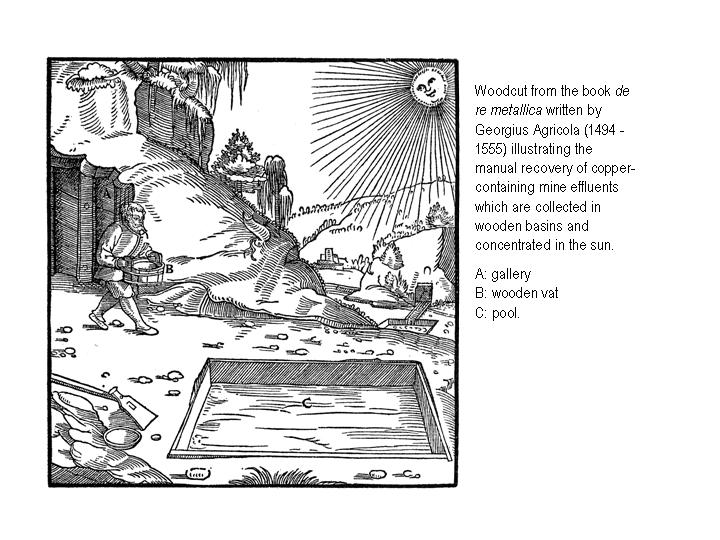

WHEREAS it has become apparent to the citizens of Iron Mountain Mine, that there is no security for life and property, either under the regulations of society as it at present exists, or under the law as now administered; Therefore the citizens, whose names are hereunto attached, do unit themselves into an association for the maintenance of the peace and good order of society, and the preservation of the lives and property of the citizens of Iron Mountain Mine, and do bind ourselves, each unto the other, to do and perform every lawful act for the maintenance of law and order, and to sustain the laws when faithfully and properly administered; but we are determined that no thief, burglar, incendiary or assassin, shall escape punishment, either by the quibbles of the law, the insecurity of prisons. the carelessness or corruption of the police, or a laxity of those who pretend to administer justice.
Conference on The State of Environmental Justice at Iron Mountain Mine
Statement of Purpose
Purpose and goals of conference (Mission):
The year 2010 marked the 160th anniversary of Shasta County, the 30 th anniversary of Superfund, and the 18 th anniversary of the National Law Journal's work that found inequitable enforcement of environmental laws by race and income.
Expected outcomes:
Audience:
The conference seeks to bring together federal employees, academics, business and industry, non-profit organizations, tribes, faith-based organizations, local community activists and others to participate in dialog on achieving equality of environmental protection. The conference will serve as an academic legal conference to advance scholarship regarding environmental justice. A related goal of this conference is to expose law students to the myriad and complicated aspects of environmental justice.
Conference Planning Process:
Conference planning is organized around an overarching Planning Committee and Work Committees.
Planning Committee:
The committee will ensure papers and conference speakers represent the diversity in profession and ideas and strategies for achieving environmental justice.
Work Committees:
Budget
Sponsors
Facilities and Site Selection
PR/Outreach
Plenary
Track Management
Track Managers
EJ and Health Disparities
Land Use Planning
Public Participation in Decision Making
EJ in Indian Country
EJ in Mining Territory
Policies on Key Issues (and measures taken to address them), such as but not limited to:
Mr. T.W. Arman, proprietor , Iron Mountain Mines, Inc., & 'ARMAN' for archaeal Richmond Mine acidophilic nanoorganisms
All the rights, privileges, and immunities of the Camden and Magee Military Scrip Warrants for the United States of America State of California Morrill Act University of California San Buena Ventura Agricultural College Patent. May 1, 1862 - President Abraham Lincoln
Since 1849 - Flat Creek Mining District
Since May 1, 1862 - Camden & Magee Agricultural College, Military Scrip Warrant Freehold Estate; 360 acres of land in lieu of Rancho Buena Ventura grant patent title,
President Abraham Lincoln - Morrill Land-Grant Colleges Act
1844 Mexican Land Grant and Bounty Warrants prior rights; Rancho San Buena Ventura; Perdido Californio Bosque del Norte . Good Fortune Ranch; Lost California Forest of the North
Since Janurary 4, 1875 - Shasta County Recorder; Morrill land grant Act of Congress - Camden & Magee University of California Agricultural College Patent by Governor Newton Booth.
Since April 8, 1880 - Lost Confidence Mine, Camden North, Camden South, Magee Apex, Sallee Anticline, Sallee Syncline, J Fault, Bear's Den, Bear's Nest, Number 8, Complex, Hornet Gold & Silver, Homestake, Foresight, Backsight, Thistle, Finegold, Oversight, Goldbar, Owl, Grey Squirrel, Ole Hanson, Wedge, Big Dipper, Last Link, Kitchener, Keystone, Pershing, Esther, Spring Creek, Minnesota, Crown Point & Red Star lode Mining Claims.
Since 1895 - Mountain Copper Co. Ltd., Iron Mountain Investment Co. 2898 ACRES OF LAND (Jardine Matheson/ Rothschilds/ Keswick, et al), Iron Mountain Investment Co. The Noble and Scott, Richmond, Lawson, Hoover, Pershing, Tuxedo, Highland, Paradise, Congress, Prince Albert, Claremont, Mocop, Bennington, Canyon, Consolidated lode Mining Claims, &c.
Since 1967 - Stauffer Chemical Co., 8000 ACRES OF LAND - BRICK FLAT PIT ABANDONMENT -(Rhône Polenc, Aktemix 37, Imperial Chemical (ICI America), Aventis Crop Science, AstraZeneca, Bayer Crop Sciences et al), Responsible Parties to Consent Decree.
Since 1976 - Iron Mountain Mines, Inc., 4400 ACRES OF LAND, Innocent landowner - operator Mr. T.W. Arman, 2744 ACRES OF LAND, sole stockholder.
Since 2001 - Essential Solutions, Inc. 52,000 ACRES OF LAND, Agricultural & Horticultural Products Research.
Since 2008 - Hu/Mountain joint venture 88,000 ACRES OF LAND - Relocation, Rediscoveries, Remission, Reversion, Restitution, Remainder, Resource Recovery, Renovation, Residency, Recycling, Reclamation, Reuse, Reinsurance, Reworking, Repossession, Reparations and Repatriations, &c.
IRON MOUNTAIN MINE PROPOSES TO DEVELOP BIOLOGICAL HYDRAULIC MINING WITH 'ARMAN'
Enigmatic, ultrasmall, uncultivated Archaea
Gregory J. Dick a , 1 ,
Doug Hyatt c ,
Robert L. Hettich d , and
Jillian F. Banfield a , e , 2
+ Author Affiliations
e Environmental Science, Policy, and Management, University of California, Berkeley, CA 94720;
b Lawrence Berkeley National Laboratories, Berkeley, CA 94720; and
d Chemical Sciences Divisions, Oak Ridge National Laboratory, Oak Ridge, TN 37831
? 1 Present address: Department of Geological Sciences, University of Michigan, Ann Arbor, MI 48109.
Edited by Norman R. Pace, University of Colorado, Boulder, CO, and approved March 30, 2010 (received for review December 16, 2009)
Abstract
Metagenomics has provided access to genomes of as yet uncultivated microorganisms in natural environments, yet there are gaps in our knowledge—particularly for Archaea—that occur at relatively low abundance and in extreme environments. Ultrasmall cells (<500 nm in diameter) from lineages without cultivated representatives that branch near the crenarchaeal/euryarchaeal divide have been detected in a variety of acidic ecosystems. We reconstructed composite, near-complete ~1-Mb genomes for three lineages, referred to as ARMAN (archaeal Richmond Mine acidophilic nanoorganisms), from environmental samples and a biofilm filtrate. Genes of two lineages are among the smallest yet described, enabling a 10% higher coding density than found genomes of the same size, and there are noncontiguous genes. No biological function could be inferred for up to 45% of genes and no more than 63% of the predicted proteins could be assigned to a revised set of archaeal clusters of orthologous groups. Some core metabolic genes are more common in Crenarchaeota than Euryarchaeota , up to 21% of genes have the highest sequence identity to bacterial genes, and 12 belong to clusters of orthologous groups that were previously exclusive to bacteria. A small subset of 3D cryo-electron tomographic reconstructions clearly show penetration of the ARMAN cell wall and cytoplasmic membranes by protuberances extended from cells of the archaeal order Thermoplasmatales . Interspecies interactions, the presence of a unique internal tubular organelle [Comolli, et al. (2009) ISME J 3:159–167], and many genes previously only affiliated with Crenarchaea or Bacteria indicate extensive unique physiology in organisms that branched close to the time that Cren - and Euryarchaeotal lineages diverged.
Weird, Ultra-Small Microbes Turn Up in Acidic Mine Drainage
ScienceDaily (May 6, 2010) — In the depths of a former copper mine in Northern California dwell what may be the smallest, most stripped-down forms of life ever discovered.
The microbes -- members of the domain of one-celled creatures called Archaea -- are smaller than other known microorganisms, rivaled in size only by a microbe that can survive solely as a parasite attached to the outside of other cells. Their genomes, reconstructed by a group at the University of California, Berkeley, are among the smallest ever reported.
The researchers also discovered another mine-dwelling microbe that occasionally produces weird protuberances unlike any structures seen before in Archaea and uses them to penetrate the ultra-small microbes.
"Other cells in the mine have what looks like a needle that sometimes pokes right into the cells," said Brett J. Baker, a researcher in UC Berkeley's Department of Earth and Planetary Science and first author of a new paper describing the findings. "It is really remarkable and suggests an interaction that has never been described before in nature."
These cellular extensions are only present when this interaction between the microbes is seen, noted co-author Luis R. Comolli, a microscopist at Lawrence Berkeley National Laboratory (LBNL).
Baker, Comolli and a team led by Jillian Banfield, UC Berkeley professor of earth and planetary science and of environmental science, policy and management and staff scientist at LBNL, published their findings in the online early edition of the journal Proceedings of the National Academy of Sciences .
Under a light microscope, the ultra-small microbes look like specks of dust. But Comolli used a state-of-the-art cryoelectron microscope, or cryoEM, to obtain high-resolution, 3-D images and even measure an individual microbe's internal volume -- between one-tenth and one-hundredth the volume of an E. coli bacterium. Each of the microbes, dubbed ARMAN, for archaeal Richmond Mine acidophilic nanoorganisms, is ellipsoidal and only 200-400 nanometers in diameter, one-third the diameter of the rod-shaped E. coli .
The team reconstructed the genomes of three distinct lineages of ARMAN and found them to be tiny -- a mere 1 million base pairs, in contrast to hundreds of billions in humans. In the smallest of the three, the average gene length is only 774 base pairs, in contrast to the average gene length in humans of 10,000 to 15,000 base pairs. Base pairs, the smallest chemical units of the gene, are nucleic acids that come in four forms. The base pairs are chained together to make DNA, and a gene is a sequence of base-pairs coding for a unique protein.
The genomes are so small that the researchers initially suspected that the ARMAN microbes are parasites upon other microbes, since parasites can afford to lose genes that their host already has.
But of the 70 individual specimens so far imaged in 3-D, 90 percent seem to be free-living. The other 10 percent are impaled on the mysterious needle-like spines of Thermoplasmatales, the other Archaea living alongside ARMAN in the mine. The researchers suspect that the penetrating spines may mean that the microbes live off other microbes at least part of the time, unlike symbiotic organisms or parasites, which must always associate with other organisms to live.
"ARMAN are among the smallest microbes we know of that, if not free-living, are at least not permanently obliged to be a parasite or symbiont," Comolli said.
The cells are about as large as the largest viruses, which can replicate only in living organisms and are not considered to be "living."
"The genome is very compact," Baker added." A microbial genome 10 percent larger has the same number of genes as ARMAN."
The organism has a much higher percentage -- 45 percent -- of unknown genes than any other organism sequenced, he said.
"ARMAN share a lot of genes with Euryarchaeota and Crenarchaeaota , but they also have a lot of genes not seen before in these branches of Archaea ," he said, suggesting that ARMAN may have been around since these two branches split billions of years ago.
Three-dimensional cryoEM tomographic reconstructions show the unique architecture of ARMAN, Comolli said. It has very few ribosomes -- the machines that build proteins per unit volume, for example; in the same volume, E coli would have 100 times more. The ribosomes also are distributed close to the cell wall. ARMAN cells also have an enigmatic internal tube. Like other Archaea , however, they have no nucleus or other internal organelles.
Banfield's group first described the ARMAN microbes four years ago, after identifying the organisms in acidic pools in the Richmond Mine, which is owned by Ted Arman, in Iron Mountain, Calif. The team's continued analysis has revealed amazing organization within the mine drainage biofilm communities that grow on solutions with the acidity of battery acid. The new data will help the researchers explore even further the community of organisms in the mine and determine how the organisms are able to live in such harsh environs and convert iron sulfides to sulfuric acid.
"Having these microbes described at the genomic level allows us to develop molecular identification methods and combine these methods with a 3-D view of the microbes to study the distribution of these organisms within this little ecological system, this little society, in the mine," Comolli said.
The work was supported by the Department of Energy and the National Aeronautics and Space Administration Astrobiology Institute. Sequencing was provided by the Community Sequencing Program at the Department of Energy Joint Genome Institute. This work was supported by DOE Genomics:GTL project Grant No. DE-FG02-05ER64134 (Office of Science) and sequencing was done at the DOE Joint Genome Institute. AFA was supported by grants from the Swedish Research Council and Carl Tryggers Foundation.
Community-wide analysis of microbial genome sequence signatures
Gregory J Dick, 1, 3 Anders F Andersson, 1, 4, 5 Brett J Baker, 1 Sheri L Simmons, 1 Brian C Thomas, 1 A Pepper Yelton, 1 and Jillian F Banfield 1, 2 1 Department of Earth and Planetary Science, University of California, 307 McCone Hall, Berkeley, CA 94720, USA 2 Department of Environmental Science, Policy, and Management, University of California, Hilgard Hall, Berkeley, CA 94720, USA 3 Current address: Department of Geological Sciences, University of Michigan, 1100 N. University Ave, Ann Arbor, MI 48109-1005, USA 4 Current address: Evolutionary Biology Centre, Department of Limnology, Uppsala University, Norbyv. 18 D, SE-75236, Uppsala, Sweden 5 Current address: Department of Bacteriology, Swedish Institute for Infectious Disease Control, Nobels väg 18 SE-17182 Solna, Sweden Corresponding author. Gregory J Dick: gdick@umich.edu ; Anders F Andersson: doubleanders@gmail.com ; Brett J Baker: acidophile@gmail.com ; Sheri L Simmons: sherisim@gmail.com ; Brian C Thomas: bcthomas@berkeley.edu ; A Pepper Yelton: pepperyelton@hotmail.com ; Jillian F Banfield: jbanfield@berkeley.edu Received April 29, 2009; Revised July 10, 2009; Accepted August 21, 2009.
Abstract Background Analyses of DNA sequences from cultivated microorganisms have revealed genome-wide, taxa-specific nucleotide compositional characteristics, referred to as genome signatures. These signatures have far-reaching implications for understanding genome evolution and potential application in classification of metagenomic sequence fragments. However, little is known regarding the distribution of genome signatures in natural microbial communities or the extent to which environmental factors shape them. Results We analyzed metagenomic sequence data from two acidophilic biofilm communities, including composite genomes reconstructed for nine archaea, three bacteria, and numerous associated viruses, as well as thousands of unassigned fragments from strain variants and low-abundance organisms. Genome signatures, in the form of tetranucleotide frequencies analyzed by emergent self-organizing maps, segregated sequences from all known populations sharing < 50 to 60% average amino acid identity and revealed previously unknown genomic clusters corresponding to low-abundance organisms and a putative plasmid. Signatures were pervasive genome-wide. Clusters were resolved because intra-genome differences resulting from translational selection or protein adaptation to the intracellular (pH ~5) versus extracellular (pH ~1) environment were small relative to inter-genome differences. We found that these genome signatures stem from multiple influences but are primarily manifested through codon composition, which we propose is the result of genome-specific mutational biases. Conclusions An important conclusion is that shared environmental pressures and interactions among coevolving organisms do not obscure genome signatures in acid mine drainage communities. Thus, genome signatures can be used to assign sequence fragments to populations, an essential prerequisite if metagenomics is to provide ecological and biochemical insights into the functioning of microbial communities.
Background The age of genomics has opened up new perspectives on the natural microbial world, offering insights into organisms that drive geochemical cycles and are critical to human and environmental health. The prevalence of horizontal gene transfer, recombination, and population-level genomic diversity underscores the dynamic nature of bacterial and archaeal genomes and demands reconsideration of fundamental issues such as microbial taxonomy [ 1 , 2 ] and the concept of microbial species [ 3 , 4 ]. Application of genomics to uncultivated assemblages of microorganisms in natural environments ('metagenomics' or 'community genomics') has provided a new window into in situ microbial diversity and function [ 5 - 7 ]. To date, community genomics has revealed the form and extent of recombination and heterogeneity in gene content [ 8 - 11 ], elucidated virus-host interactions [ 12 ], redefined the extent of genetic and biochemical diversity in the oceans [ 13 - 15 ], uncovered new metabolic capabilities [ 16 - 19 ] and taxonomic groups [ 20 ], and shown how functions are distributed across environmental gradients [ 21 ]. An important approach to study evolutionary and ecological processes, pioneered by Karlin and others [ 22 ], is the analysis of nucleotide compositional characteristics of genomes. The simplest and most widely used measure of nucleotide composition, the abundance of guanine plus cytosine (%GC), is shaped by multiple factors encompassing both neutral and selective processes. Neutral factors include intrinsic properties of the replication, repair, and recombination machinery that result in mutational biases [ 23 , 24 ]. Selective processes encompass both internal (for example, translation machinery) and external influences such as physical (temperature, pressure), chemical (salinity, pH) and ecological factors (competition for metabolic resources [ 25 ] and niche complexity [ 26 ]). Although the relative importance of these factors remains uncertain [ 27 ], it is clear that %GC varies widely between species but is relatively constant within species. Thus, %GC has been used to trace origins of DNA fragments within genomes [ 28 ] and to assign fragmentary metagenomic sequences to candidate organisms [ 16 ]. Such inferences must be made with caution: %GC simplifies nucleotide composition down to a single parameter with known limitations for investigating genome dynamics [ 29 ]. Oligonucleotide frequencies capture species-specific characteristics of nucleotide composition more effectively than %GC [ 30 ]. Analyses of genome sequences from cultivated organisms have shown that the frequency at which oligonucleotides occur is unique between species while being conserved genome-wide within species [ 22 , 30 - 34 ]. Taken together, the frequency of all oligonucleotides of a given length defines the 'genome signature' (for example, the frequency of all possible 256 tetranucleotides). Sequence signatures are evident in oligonucleotides ranging from di- (two-mers) to octanucleotides (eight-mers). While the specificity of genome signatures increases with oligonucleotide length [ 35 ], the number of possible oligomers increases exponentially with oligomer length, so signatures based on longer oligomers require calculations over larger genomic regions to achieve sufficient sampling. Genome signatures have been used to detect horizontally transferred DNA [ 36 - 39 ], reconstruct phylogenetic relationships [ 22 , 32 , 40 ] and infer lifestyles of bacteriophage [ 41 , 42 ]. Genome signatures also offer a compelling means of assigning metagenomic sequence fragments to microbial taxa, a procedure termed 'binning' [ 43 ]. This is a prerequisite for realizing some of the most valuable opportunities random shotgun metagenomics offers, including assignment of ecological and biogeochemical functions to particular community members and assessment of population-level genomic diversity and community structure. However, binning is a formidable challenge because: the inherent diversity of microbial communities typically limits genomic assembly, resulting in highly fragmentary data [ 13 ]; there are few universally conserved phylogenetically informative markers, leaving the vast majority of metagenomic sequence fragments 'anonymous' with regard to their organism of origin; and current sequence databases grossly under-represent the microbial diversity in the natural world, limiting the utility of fragment recruitment or BLAST-based methods [ 13 , 44 , 45 ]. Consequently, it is important to develop methods that classify all genome sequence fragments independently of reference databases. Genome signatures are a promising approach for sequence classification. However, it is important to understand the source of the signal and how environmental effects and evolutionary distance will compromise it. To date, sequence signatures have been explored using genomes from cultivated microbes [ 22 , 30 - 34 ], and prospects for binning have been evaluated based largely on simulated datasets consisting of mixtures of isolate genomes [ 44 , 46 - 48 ]. Although these studies are indispensable in that they allow theoretical evaluation of binning capability, they do not represent the diversity (community-wide and within population) and dynamics (for example, horizontal gene transfer, recombination, viruses) of real microbial communities. Further, they employ genomes derived from disparate environments and so do not address the extent to which environmental factors shape genome signatures. It has been reported that environment shapes nucleotide composition [ 26 , 49 - 51 ]. If so, then genome signatures may not discriminate coexisting, coevolving organisms, especially where environmental pressures are extreme. On the other hand, binning results of real microbial communities [ 46 , 48 , 52 ] are inherently difficult to evaluate because the true identity of most sequence fragments is unknown. Thus, there remain fundamental questions regarding the forces and processes that give rise to and maintain genome signatures, and the extent to which these signatures are obscured by shared environmental pressures and community interactions such as horizontal gene transfer and broad host range viruses. Here we present a comprehensive analysis of genome signatures in sequences derived from natural biofilms inhabiting a subsurface chemolithoautotrophic acid mine drainage (AMD) ecosystem in the Richmond Mine at Iron Mountain, CA [ 53 ]. The biofilms are dominated by just a handful of organisms that are sustained primarily by the oxidation of Fe(II) derived from pyrite (FeS 2 ) dissolution [ 54 ]. Due to this relatively low diversity, modest levels of shotgun sequencing (approximately 100 Mb per sample) have yielded deep genomic sampling (10 to 20× sequence coverage) of the dominant populations, enabling reconstruction of 12 near-complete genomes from three samples [ 16 , 55 , 56 ] (BJ Baker et al ., submitted). These assembled composite genomes provide the organism affiliation of sequences with which binning accuracy can be evaluated. Therefore, the dataset allows assessment of binning performance while capturing sequence heterogeneity that is an intrinsic feature of natural microbial populations. We find that AMD biofilm microorganisms are indeed distinguished by population-specific genome signatures and show that sequence signatures can be used to identify and cluster sequences from low-abundance community members de novo , without reference genomes or reliance on databases. Our results have implications for metagenomic binning and provide new insights into the sources of genome signatures that distinguish coexisting populations.
Results Description of samples, community genomic sequencing and assembly An overview of our methodology is shown in Figure Figure1. 1 . Community genomic sequence was obtained from two previously described biofilm samples from the UBA location of the Richmond Mine at Iron Mountain: a pink subaerial biofilm collected in June 2005 ('UBA') [ 55 ] and a thicker floating biofilm collected in November 2005 ('UBA BS') [ 12 ]. These two biofilms contained overlapping subsets of organisms in different proportions. The UBA biofilm was dominated by bacterial Leptospirillum spp. group II and group III ( Nitrospirae ) populations, for which near-complete genomes have been reconstructed [ 55 , 56 ]. The most abundant microorganisms represented in the UBA BS genomic data were from archaeal populations, including an uncultivated representative of a novel euryarchaeal lineage, ARMAN-2 [ 20 ], and A-plasma, E-plasma, and I-plasma, members of the order Thermoplasmatales. To facilitate reconstruction of genomes from these and other lower-abundance organisms, a combined assembly included unassigned sequences from UBA and all sequences from UBA BS. Random shotgun sequences derived from both ends of approximately 3-kb DNA fragments, and each fragment was likely sampled from a different individual cell with a potentially distinct genome sequence. Therefore, genome reconstructions represent composite sequences. However, single nucleotide polymorphism density was typically very low (< 0.3%). For a small subset of the many cases where there were subpopulations with different gene content, alternative genome paths were also reconstructed [ 9 , 55 ].
Proteogenomic basis for ecological divergence of closely related bacteria in natural acidophilic microbial communities
Linda H. Kalnejais a , 1 ,
Paul Wilmes a ,
Robert L. Hettich b , and
+ Author Affiliations
? 1 Present address: University of New Hampshire, Durham, NH 03824.
Abstract
Bacterial species concepts are controversial. More widely accepted is the need to understand how differences in gene content and sequence lead to ecological divergence. To address this relationship in ecosystem context, we investigated links between genotype and ecology of two genotypic groups of Leptospirillum group II bacteria in comprehensively characterized, natural acidophilic biofilm communities. These groups share 99.7% 16S rRNA gene sequence identity and 95% average amino acid identity between their orthologs. One genotypic group predominates during early colonization, and the other group typically proliferates in later successional stages, forming distinct patches tens to hundreds of micrometers in diameter. Among early colonizing populations, we observed dominance of five genotypes that differed from each other by the extent of recombination with the late colonizing type. Our analyses suggest that the specific recombinant variant within the early colonizing group is selected for by environmental parameters such as temperature, consistent with recombination as a mechanism for ecological fine tuning. Evolutionary signatures, and strain-resolved expression patterns measured via mass spectrometry–based proteomics, indicate increased cobalamin biosynthesis, (de)methylation, and glycine cleavage in the late colonizer. This may suggest environmental changes within the biofilm during development, accompanied by redirection of compatible solutes from osmoprotectants toward metabolism. Across 27 communities, comparative proteogenomic analyses show that differential regulation of shared genes and expression of a small subset of the ~15% of genes unique to each genotype are involved in niche partitioning. In summary, the results show how subtle genetic variations can lead to distinct ecological strategies.
by VJ Denef - 2010 - Cited by 5 - Related articles
Feb 9, 2010 ... We thank Mr. T. W. Arman (President, Iron Mountain Mines Inc.) and ... Contributed by Jillian F. Banfield , November 13, 2009 (sent for review July 21, 2009) ..... PNAS Profiles. (Biographical profiles of Academy members) ...
The work was supported by the Department of Energy and the National Aeronautics and Space Administration Astrobiology Institute. Sequencing was provided by the Community Sequencing Program at the Department of Energy Joint Genome Institute. This work was supported by DOE Genomics:GTL project Grant No. DE-FG02-05ER64134 (Office of Science) and sequencing was done at the DOE Joint Genome Institute. AFA was supported by grants from the Swedish Research Council and Carl Tryggers Foundation.
under the circumstances of the case the demand for entry or inspection is arbitrary and capricious, an abuse of discretion, or otherwise not in accordance with law.
Iron Mountain Mine and T.W. Arman intervene, "two miners"
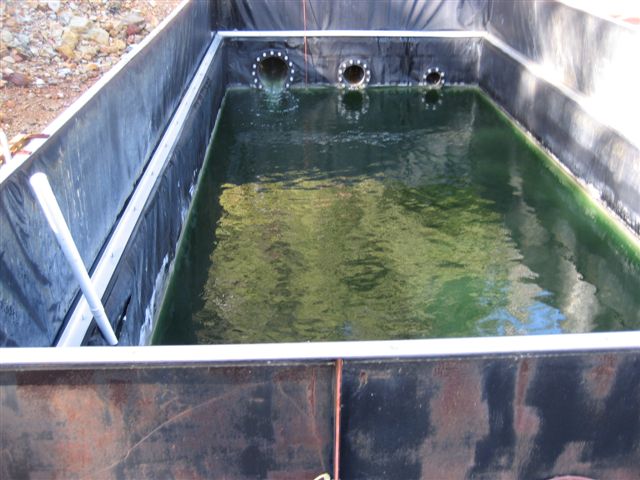 AMD GRIT TANK AT RICHMOND PORTAL
AMD GRIT TANK AT RICHMOND PORTAL
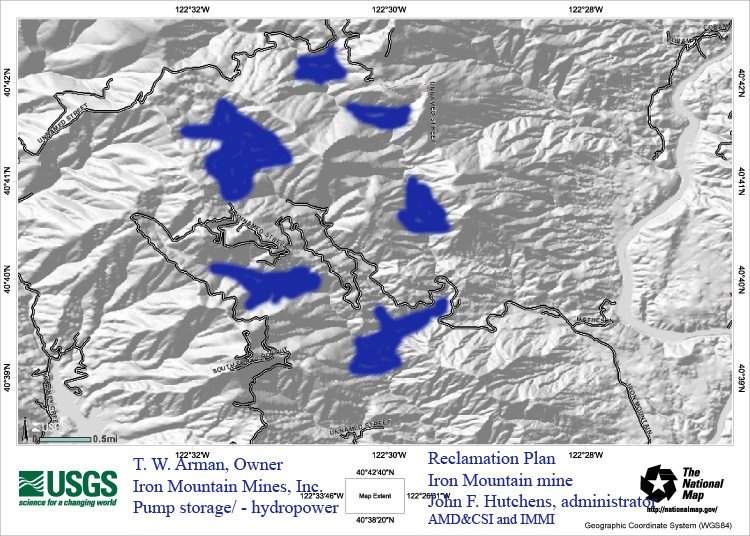
Sub specie mali : The stream of thought flows on; but most of its segments fall into the bottomless abyss of oblivion.
-William James